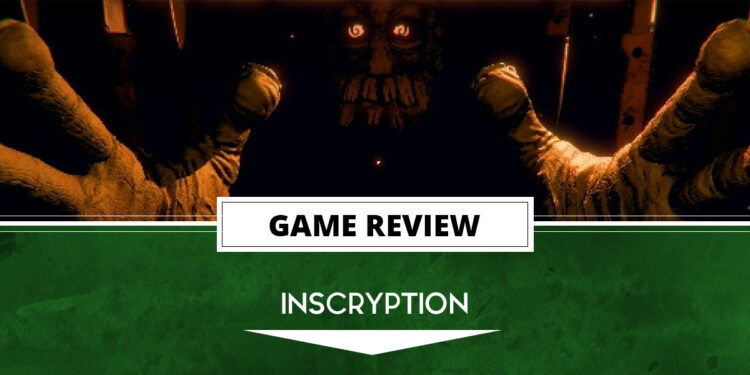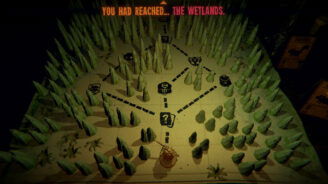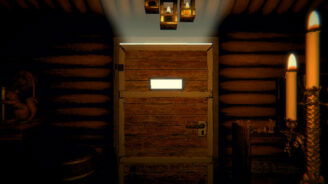The title of the game Inscryption refers to the act of inscribing info on a card, characters you meet in the game’s story, and the title of the fictional card game you play. The game’s title also—probably coincidentally—sounds like Inception. But it is in fact a game inside a game inside a game. Inscryption starts as a relatively simple digital card game. You have various creatures that you can play or use as sacrifices to summon stronger creatures. You then use these to defeat your opponent, a man hidden in shadow, and add tiny weights to a scale on the side of the playing field. Once the scale fully tips, the round ends. But who is this shrouded man? Why does he compare you to someone who played him before? And why do your cards suddenly start speaking to you?
Game Name: Inscryption
Platforms: PC, Linux, Mac, PlayStation 4 (Reviewed), PlayStation 5
Publisher: Devolver Digital
Developer: Daniel Mullins Games
Release Date: August 30th, 2022
Price: $19.99
Inscryption is not just a digital deck-building game, but games of multiple genres that expand over time. I don’t want to spoil too much, but I do believe that knowing there’s more to Inscryption than meets the eye is essential. After making waves on PC, Inscryption has arrived on PlayStation with a few added features but the same air of mystery. In between rounds of playing cards, characters switch to another tabletop game in the form of a roguelite board game. Initially, you move your piece linearly from encounter to encounter but quickly get the option to take various branching paths.
Symbols denote what occurs along each path, such as a campfire, a trader, or a sacrifice. These events facilitate upgrading cards, changing their attributes, and altering the game in various ways between rounds. Imagine playing a card game in which the joys of getting new cards, trading with friends, and making up your own rules get baked into the game itself. That’s the genius of Inscryption.
These encounters alter the gameplay of the core card game, but the rules also change over time. It’s easy to want just one more round of play, especially when a new rule or mechanic comes into play. Changes can come suddenly, and some can be hard to grasp in the moment. As such, sometimes losing a round can work in one’s favor. Inscryption is one of those self-referential games where losing is a part of the game itself. The metagame isn’t just a neat addition, it’s mandatory, for better and for worse.
The next layer of the game involves getting up from the table your character sits at and trying to find a way out of the cabin you inhabit. Solving puzzles around the cabin can prove satisfying, as it gives you extra context and even new cards and items. But moving the entire game forward, or backwards, occurs through rounds of the card game. Losing a certain number of rounds will reset the game, and there’s an in-universe explanation for what that means. When I lost, I was not disappointed—the first time.
When one loses this way, the whole game starts over. On the one hand, the player gets a new item and new content. On the other, it can continue in an endless cycle of monotony if players forget to move forward in the metagame. The card games are so addictive that it can be easy to forget to Keep. Checking. The. Cabin. You simply cannot advance past the lengthy first act without solving the puzzles throughout. You can defeat the final boss, but the game will pull a move straight out of the Yu-Gi-Oh TV show by invalidating your win and sending you back to the beginning. You can beat someone at a card game, but you don’t truly win without the powers of friendship, or by finding out what your card friends want from you. The game would improve with these side characters talking more about the cabin, since at a certain point they just drop off. Even nixing the puzzle elements, as clever as they are, would mark an improvement. It feels like Inscryption knows that people came to play an inventive deck-building game but also really wants you to find its meta puzzles just as engaging. There’s a fine line between fun and frustration in having to replay a section over and over. Unfortunately, this quickly falls into the latter.
But while unraveling certain puzzles can feel like a chore, most of the mystery of Inscryption proves a delight. Towards the end of the first act, the game pulls back the curtain with an even more meta twist regarding what’s happening. And this is still Act 1 we’re talking about. Act 2 trades the horror puzzle game of the first act for a complete switch into a retro role-playing game. Here, the game hits its stride, with narrative and gameplay blending together. The card games still make up the core of this act, but they get bolstered by secret areas, side quests, and other elements commonly found in classic RPGs. The card games become more fun as their stakes lower while their challenges become more inventive. If you die, the game doesn’t end here. The battles prove harder and the cards more diverse. One card in particular is hilariously broken, based around a strategy that involves constantly reviving it. Finally, Act 2 provides a repetitive loop that’s a thrill, not a chore.
I won’t go into more detail about Act 2 but it proves a high point of the game. I’ll say even less about Act 3, which marks a step down from Act 2 as a return to the card game/board game/puzzle formula of the first act. It adds another unique twist to the card game and, most importantly, has less-obtrusive puzzles that don’t punish you for wanting to play cards. Certain optional events, like getting rid of a card, aren’t well signposted here, and there’s no way to back out of them once you interact. The PlayStation version offers nice aesthetics with sounds and lights coming from the controller, but navigating the main interface is a bit cumbersome. Meanwhile, the overarching framing narrative during all of this offers intrigue, but I felt a bit let down with the payoff—or lack thereof. Still, it hooked me along well enough to keep me playing, even when stuck in the bizarre loop of the first act. And I’m glad I waded through that, as I enjoyed the variety of aesthetics and mechanics that continued to unfold.
Inscryption does many disparate things and so many of them so well. The concept of Hearthstone meets The Seventh Seal with a side of The Blair Witch Project does not sound like it should exist, and yet here we have it. From a gameplay standpoint, the title offers everything from card games, to tabletop games, to puzzle-solving, to role-playing. If I were to review each act separately, I’d say the first act is middling, the second is fantastic, and the third act is good enough. But of course, you have to play them in order and they’re all part of the same game. After all, it’s not the individual cards that matter, but the whole deck that counts.
Inscryption Review
Inscrypton Review
Inscryption is a Frankenstein creation like one of its gruesome hybrid cards. It takes a bunch of different pieces, sows them all together, and creates a game that’s a bit wonky in some places but otherwise inventive and unique.
Pros
- Genre changes and twists that keep things interesting.
- Addictive deckbuilding game at its core.
- Great balance of gameplay varieties and story and design in the second act.
- Extra light and sound features through the PlayStation controller.
Cons
- Repetitive and gimmicky puzzle mechanics too clever for their own good.
- Story is a bit of a letdown without the online ARG that explains it.
-
Inscryption Review





